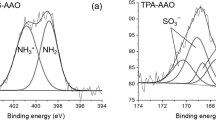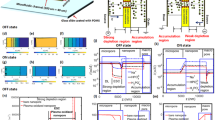Abstract
An electroosmotic EO process is presented for nanoporous membranes capable of generating EO flow rates over thirty times higher than previously possible with the same membrane and solution. In generating high EO flows, a limiting factor is faradaic reactions which appear at high electric fields. A process is presented capable of limiting and even canceling these reactions allowing electric field between one and two orders of magnitude higher. This is achieved by applying an asymmetric bipolar rectangular voltage waveform. The results show the enhanced EO pumping capabilities of membranes under a high electric field asymmetric waveform which prevents gas generation at high voltages. A baseline is established by measuring the EO pump performance when a constant voltage is applied to SiO2-coated nanoporous anodic aluminum oxide membranes. The analysis compares the effect of the applied voltage type on the maximum flow rate, power consumption, and maximum pressure. Results show that large gas generation prevents membrane operation when direct current DC voltages above 50 V are applied. On the other hand, it operates normally under an asymmetric voltage +1,800/−900 V applied, with negligible gas generation. This results in a thirty-time flow rate increase. Larger flow rates/voltages are possible but were not considered due to hardware limitations.












Similar content being viewed by others
References
Ai Y, Yalcin SE, Gu D, Baysal O, Baumgart H, Qian S, Beskok A (2010) A low-voltage nano-porous electroosmotic pump. J Colloid Interface Sci 350(2):465–470
Arulanandam S, Li D (2000) Determining ζ potential and surface conductance by monitoring the current in electro-osmotic flow. J Colloid Interface Sci 225(2):421–428
Berrouche Y, Avenas Y, Schaeffer C, Hsueh-Chia Chang, Ping Wang (2009) Design of a porous electroosmotic pump used in power electronic cooling. IEEE Trans Ind Appl 45(6):2073–2079
Brask A, Snakenborg D, Kutter JP, Bruus H (2006) AC electroosmotic pump with bubble-free palladium electrodes and rectifying polymer membrane valves. Lab Chip 6(2):280
Buie CR, Posner JD, Fabian T, Cha S-W, Kim D, Prinz FB, Eaton JK, Santiago JG (2006) Water management in proton exchange membrane fuel cells using integrated electroosmotic pumping. J Power Sources 161(1):191–202
Burke JM, Smith CD, Ivory CF (2010) Development of a membrane-less dynamic field gradient focusing device for the separation of low-molecular-weight molecules. Electrophoresis 31(5):902–909
Cao Z, Yuan L, Liu Y-F, Yao S, Yobas L (2012) Microchannel plate electro-osmotic pump. Microfluid Nanofluid 13(2):279–288
Chen L (2005) Fabrication and characterization of a multi-stage electroosmotic pump for liquid delivery. Sensors Actuators B Chem 104(1):117–123
Chen L, Ma J, Guan Y (2004) Study of an electroosmotic pump for liquid delivery and its application in capillary column liquid chromatography. J Chromatogr A 1028(2):219–226
Chen W, Yuan JH, Xia XH (2005) Characterization and manipulation of the electroosmotic flow in porous anodic alumina membranes. Anal Chem 77(24):8102–8108
Chen Y-F, Li M-C, Hu Y-H, Chang W-J, Wang C-C (2007) Low-voltage electroosmotic pumping using porous anodic alumina membranes. Microfluid Nanofluid 5(2):235–244
Chen J-K, Weng C-N, Yang R-J (2009) Assessment of three AC electroosmotic flow protocols for mixing in microfluidic channel. Lab Chip 9(9):1267
Chen Y-F, Hu Y-H, Chou Y-I, Lai S-M, Wang C-C (2010) Surface modification of nano-porous anodic alumina membranes and its use in electroosmotic flow. Sensors Actuators B Chem 145(1):575–582
Donose BC, Harnisch F, Taran E (2012) Electrochemically produced hydrogen bubble probes for gas evolution kinetics and force spectroscopy. Electrochem Commun 24:21–24
Garg R, Kumar V, Kumar D, Chakarvarti SK (2012) Electrical transport through micro porous track etch membranes of same porosity. Mod Phys Lett B 26(31):1250209
Heuck F, Van der Ploeg P, Staufer U (2011) Deposition and structuring of Ag/AgCl electrodes inside a closed polymeric microfluidic system for electroosmotic pumping. Microelectron Eng 88(8):1887–1890
Kim Y, Cha M, Choi Y, Joo H, Lee J (2013) Electrokinetic separation of biomolecules through multiple nano-pores on membrane. Chem Phys Lett 561–562:63–67
Kirby BJ, Hasselbrink EF (2004) Zeta potential of microfluidic substrates: 1. Theory, experimental techniques, and effects on separations. Electrophoresis 25(2):187–202
Kohlheyer D, Eijkel JCT, Schlautmann S, Van den Berg A, Schasfoort RBM (2008) Bubble-Free Operation of a Microfluidic Free-Flow Electrophoresis Chip with Integrated Pt Electrodes. Anal Chem 80(11):4111–4118
Kwon K, Park C-W, Kim D (2012) High-flowrate, compact electroosmotic pumps with porous polymer track-etch membranes. Sens Actuators, A 175:108–115
Levine S, Marriott JR, Robinson K (1975) Theory of electrokinetic flow in a narrow parallel-plate channel. J Chem Soc, Faraday Trans 2(71):1–11
Li PCH, Harrison DJ (1997) Transport, manipulation, and reaction of biological cells on-chip using electrokinetic effects. Anal Chem 69(8):1564–1568
Lin C-W, Yao S, Posner JD, Myers AM, Santiago JG (2007) Toward orientation-independent design for gas recombination in closed-loop electroosmotic pumps. Sensors Actuators B Chem 128(1):334–339
McBride SE (1999) Balanced asymmetric electronic pulse patterns for operating electrode-based pumps. US Patent 5,964,977, filed 21 Mar 1997 and issued 12 Oct 1999
Miao J-Y, Xu Z-L, Zhang X-Y, Wang N, Yang Z-Y, Sheng P (2007) Micropumps based on the enhanced electroosmotic effect of aluminum oxide membranes. Adv Mater 19(23):4234–4237
Pikal MJ (1992) The role of electroosmotic flow in transdermal iontophoresis. Adv Drug Deliv Rev 9(2):201–237
Prakash P, Grissom MD, Rahn CD, Zydney AL (2006) Development of an electroosmotic pump for high performance actuation. J Membr Sci 286(1–2):153–160
Reichmuth DS, Chirica GS, Kirby BJ (2003) Increasing the performance of high-pressure, high-efficiency electrokinetic micropumps using zwitterionic solute additives. Sensors Actuators B Chem 92(1–2):37–43
Rice CL, Whitehead R (1965) Electrokinetic flow in a narrow cylindrical capillary. J Phys Chem 69(11):4017–4024
Selvaganapathy P, Yit-shun Leung Ki, Renaud P, Mastrangelo CH (2002) Bubble-free electrokinetic pumping. J Microelectromech Syst 11(5):448–453
Stuetzer OM (1959) Ion drag pressure generation. J Appl Phys 30(7):984–994
Vajandar SK, Xu D, Markov DA, Wikswo JP, Hofmeister W, Li D (2007) SiO2-coated porous anodic alumina membranes for high flow rate electroosmotic pumping. Nanotechnology 18(27):275705
Vogt H (2011) On the gas-evolution efficiency of electrodes I-Theoretical. Electrochim Acta 56(3):1409–1416
Wang P, Chen Z, Chang H-C (2006) A new electro-osmotic pump based on silica monoliths. Sensors Actuators B Chem 113(1):500–509
Wang C, Wang L, Zhu X, Wang Y, Xue J (2012) Low-voltage electroosmotic pumps fabricated from track-etched polymer membranes. Lab Chip 12(9):1710
Xu Z, Miao J, Wang N, Wen W, Sheng P (2011) Digital flow control of electroosmotic pump: Onsager coefficients and interfacial parameters determination. Solid State Commun 151(6):440–445
Yao S, Santiago JG (2003) Porous glass electroosmotic pumps: theory. J Colloid Interface Sci 268(1):133–142
Yao S, Hertzog DE, Zeng S, Mikkelsen JC, Santiago JG (2003) Porous glass electroosmotic pumps: design and experiments. J Colloid Interface Sci 268(1):143–153
Yao S, Myers AM, Posner JD, Rose KA, Santiago JG (2006) Electroosmotic pumps fabricated from porous silicon membranes. J Microelectromech Syst 15(3):717–728
Zeng S, Chen CH, Mikkelsen JC, Santiago JG et al (2001) Fabrication and characterization of electroosmotic micropumps. Sensors Actuators B Chem 79(2–3):107–114
Acknowledgments
The authors gratefully acknowledge the financial support provided for this study by the Office of Naval Research (ONR), Grant No. N00014-11-1-0019, with Dr. Thomas F. Swean of the Ocean Engineering and Marine Systems Program serving as Program Manager. The authors are thankful to Mr. Thomas E. Hansen for all the support obtaining the EO pump video and images.
Author information
Authors and Affiliations
Corresponding author
Electronic supplementary material
Below is the link to the electronic supplementary material.
Supplementary material 1 (MP4 9654 kb)
Rights and permissions
About this article
Cite this article
Piwowar, D., Tawfik, M.E. & Diez, F.J. High field asymmetric waveform for ultra-enhanced electroosmotic pumping of porous anodic alumina membranes. Microfluid Nanofluid 15, 859–870 (2013). https://doi.org/10.1007/s10404-013-1196-7
Received:
Accepted:
Published:
Issue Date:
DOI: https://doi.org/10.1007/s10404-013-1196-7




